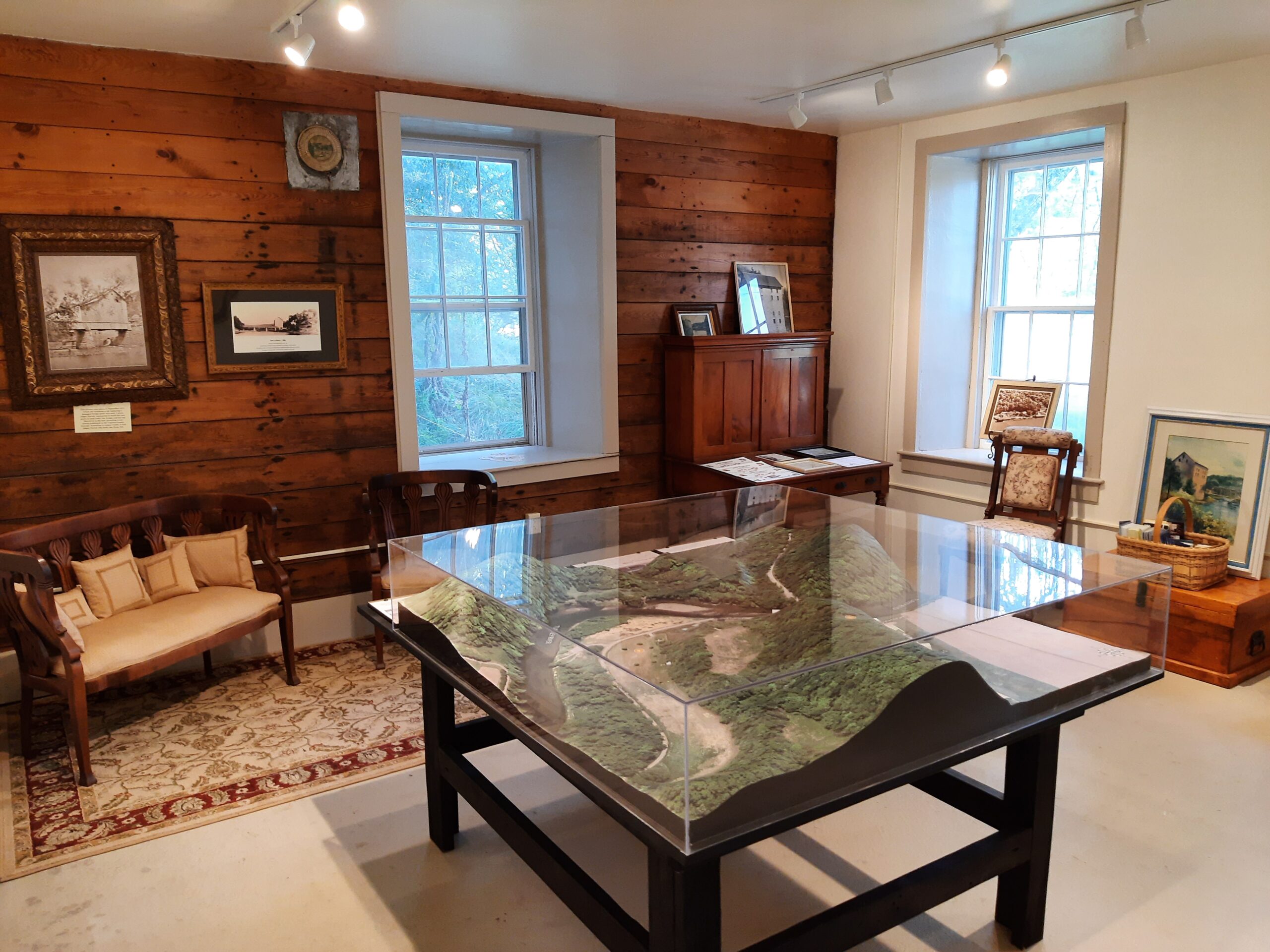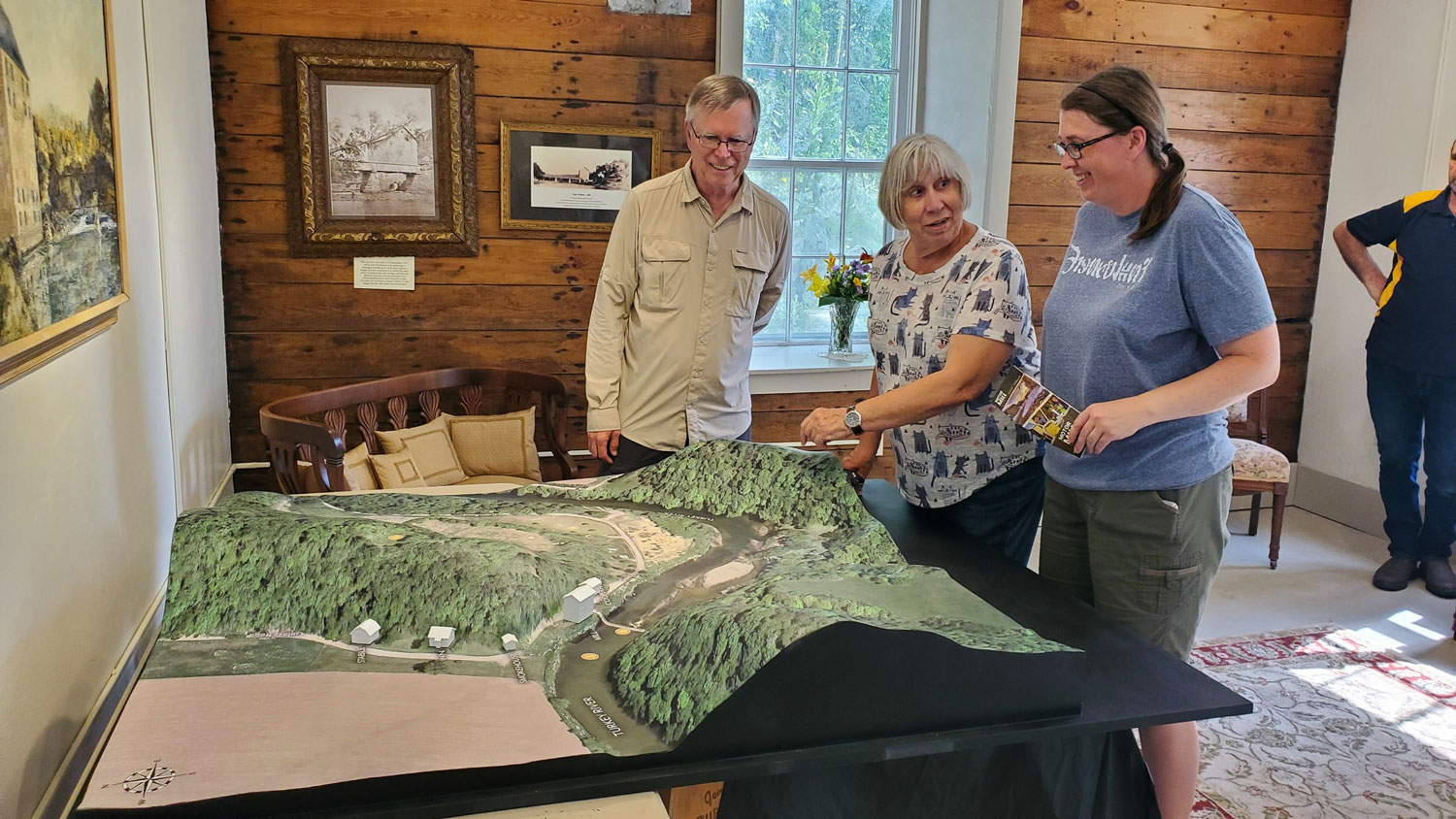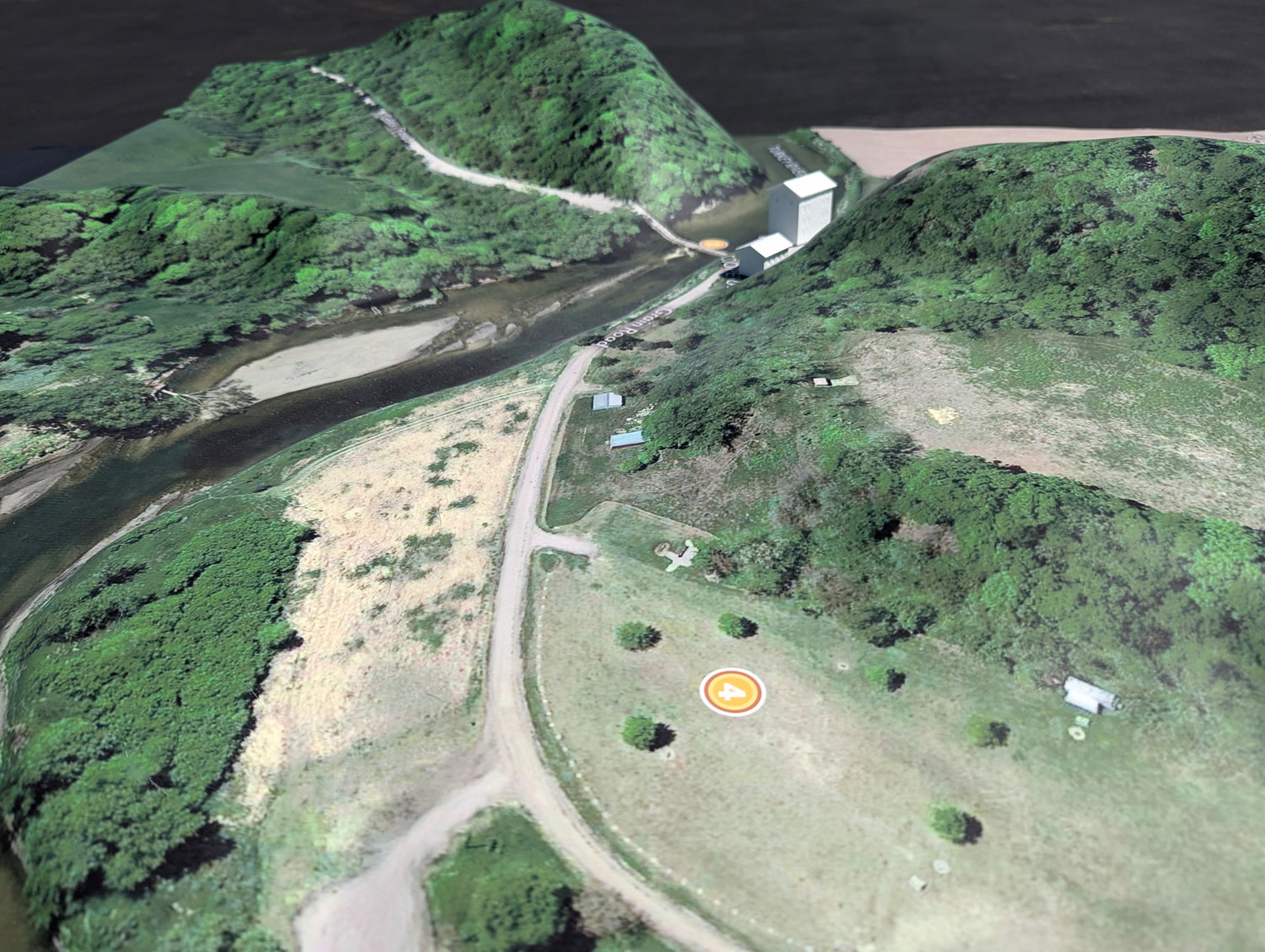3D Landscape Model of Motor Mill Historic Site
3D Landscape Model of Motor Mill Historic Site
We Build Custom 3D Raised Relief Maps
Exploring the Past in 3D: The Motor Mill Historic Site Landscape Model
Nestled in the rolling hills and river valleys of Northeast Iowa, the Motor Mill Historic Site offers a window into the past—a time when grain mills were essential to the livelihoods of communities across rural America. Built in the 1860s, the Motor Mill stands as a confirmation to the ingenuity of early industrial America, harnessing the power of the Turkey River to grind grain and sustain the local economy. Today, this historic site serves as both a public landmark and an educational experience, inviting visitors to step back in time and explore the rich history that shaped this part of the country.
But how do you transport visitors into the past when much of the original infrastructure is long gone? While the mill building itself has withstood the test of time, many other features from the late 1800s no longer exist. For visitors to fully grasp why this particular location was chosen for a grain mill—situated among the hillsides and river valley of Northeast Iowa—a more immersive approach was needed. That’s where the 3D landscape model of Motor Mill comes into play.
This innovative 3D model doesn’t just show the mill building. It helps to visualize the entire surrounding landscape, allowing visitors to understand the interplay of geography, industry, and community that once made the site thrive. The model brings back to life elements of the infrastructure that have long since disappeared, blending the past with the present in a way that encourages deeper understanding. Let’s dive into the creation of this remarkable model, the challenges it faced, and the impact it has on visitors.

Recreating the Past: The Purpose of the Motor Mill 3D Landscape Model
The Motor Mill Historic Site is more than just a single building; it’s part of a larger landscape that includes the Turkey River, wooded hillsides, and the remnants of a once-thriving mill complex. When the site managers decided to create a 3D landscape model, their goal was clear: to tell the full story of the mill’s history by showing visitors not only the mill building but also the natural and human-made features that influenced its establishment.
The choice of the location for the Motor Mill in the 1860s was no accident. The site was selected because of the nearby Turkey River, which provided the necessary power for the mill’s operation, as well as the surrounding hills, which offered protection from harsh weather and provided natural resources like limestone for building. By displaying this landscape in three dimensions, site managers could help visitors visualize these geographical advantages and understand how the mill functioned within its environment.
But the 3D model serves another purpose as well: it brings back to life aspects of the site that no longer exist. In the late 1800s, the Motor Mill complex included additional infrastructure like warehouses, stables, and worker housing. While these structures are no longer standing, the 3D model allows visitors to see where they once were, offering a glimpse into the bustling activity that would have surrounded the mill in its heyday.
Interpretive panels attached to the base of the model provide further context. These panels allow viewers to compare the past and present landscapes, highlighting changes over time and explaining the historical significance of different features. By offering both a visual and interpretive experience, the model helps visitors make connections between the history they’re learning about inside the museum and the real-life landscape they can explore just outside the door.
The Design and Fabrication Process: Crafting a Detailed 3D Landscape
Creating a 3D landscape model of the Motor Mill Historic Site was no small task. It required the collaboration of historians, cartographers, engineers, and model-makers, all working together to bring this vision to life. But what does it take to build a detailed, accurate representation of a landscape that has changed significantly over the past century?
Data Collection and Mapping
The first step in creating the 3D model was gathering accurate data about the landscape as it exists today. This involved several different techniques, including LiDAR scanning, aerial imagery, and topographical mapping. LiDAR (Light Detection and Ranging) is a technology that uses laser pulses to measure distances and create highly detailed 3D maps. By scanning the area around the Motor Mill, the project team could capture the exact contours of the land, from the hillsides to the riverbed.
Aerial imagery provided additional context, giving the model-makers a bird’s-eye view of the surrounding landscape and helping them see how the different features fit together. Meanwhile, historical maps and records were used to reconstruct the parts of the site that no longer exist, such as the layout of the additional buildings and infrastructure that would have been present in the late 1800s.
This combination of modern technology and historical research formed the foundation of the 3D model. By cross-referencing these different data sources, the team could ensure that the model would be both accurate and historically faithful.

Building the Terrain Model
Once the data was collected, the next step was to build the actual terrain model. Using a combination of 3D modeling software and traditional model-making techniques, the team began to craft the landscape. This process involved creating a base structure that represented the topography of the site—complete with the rolling hills, the meandering Turkey River, and the various elevation changes around the mill.
The terrain was then carefully sculpted to reflect the exact measurements gathered during the LiDAR scanning process. Every slope, hill, and valley was replicated in miniature, ensuring that the model captured the true character of the landscape. Additional details like trees, shrubs, and waterways were added to give the model a more lifelike appearance.
One of the most challenging aspects of this process was ensuring that the landscape model would be durable and easy to maintain. Since it would be displayed in a public space where visitors could interact with it, the materials needed to be sturdy enough to withstand wear and tear. The team opted for a combination of plastics and resins, which offered both durability and the flexibility needed to shape the terrain accurately.
Incorporating the Historical Infrastructure
While the landscape was an important part of the model, the true challenge lay in reconstructing the historical infrastructure that had once surrounded the Motor Mill. Using historical records, photographs, and maps, the project team was able to determine the approximate locations of the missing buildings, as well as their size and purpose.
These buildings—including worker housing, stables, and storage facilities—were then incorporated into the model, often represented as small, detailed structures. The goal wasn’t just to show where these buildings had once stood, but to give visitors a sense of the scale and scope of the entire mill complex. The 3D model allows them to see how the different parts of the site were interconnected, and how each building played a role in the overall operation of the mill.
Adding Metal Letters for Context and Interpretation
No 3D landscape model is complete without interpretive elements, and the Motor Mill model is no exception. To help visitors understand what they’re looking at, the model includes metal letters that label key features of the site, both past and present.
The process of creating these metal letters is both artistic and technical. First, the design team selected a font that would be easy to read while complementing the historic aesthetic of the site. Once the font was chosen, the letters were cut from sheet metal using precision tools like laser cutters. This ensured that each letter was perfectly shaped, with clean lines and consistent proportions.
After the letters were cut, they were finished with a protective coating to prevent rust and wear over time. The letters were then attached to the model, either directly on the landscape or on small plaques mounted around the base. Each label corresponds to a key feature of the site, from the mill building itself to the locations of the long-gone warehouses and housing.
These metal letters serve an important purpose: they provide context for visitors who may not be familiar with the site’s history. By labeling the different elements of the model, the letters help visitors connect the past with the present and better understand the significance of the site as a whole.

The Challenges of Reconstructing a Lost Landscape
Creating a 3D landscape model of a historical site is always a challenge, but the Motor Mill project faced several unique obstacles. One of the biggest challenges was how to accurately represent the infrastructure that no longer exists. While there were historical records available, many of them were incomplete or lacked the level of detail needed to fully reconstruct the missing buildings.
To overcome this challenge, the project team relied on a combination of historical research and educated guesswork. By studying similar mills from the same time period and region, they were able to make informed decisions about the size, shape, and placement of the missing structures. In some cases, they had to make compromises, opting for representations that were more symbolic than strictly accurate. However, the overall goal was to give visitors a sense of what the site would have looked like in its prime, even if some details couldn’t be perfectly recreated.
Another challenge was ensuring that the model would be both durable and accessible. Since the model is on display in a public space, it needed to be built to last. This meant choosing materials that could withstand the elements, as well as the occasional touch from curious visitors. The team also had to consider how to make the model accessible to all visitors, including those with disabilities. This involved careful planning of the model’s height, placement, and interpretive panels to ensure that everyone could enjoy and learn from the display.
The Visitor Experience: Bridging the Gap Between Past and Present
The Motor Mill 3D landscape model has had a profound impact on the way visitors experience the historic site. By providing a tangible, visual representation of the landscape, the model helps visitors bridge the gap between past and present, allowing them to better understand the historical context of the mill and its surroundings.
One of the most powerful aspects of the model is the way it encourages visitors to compare the landscape of today with that of the 1800s. The interpretive panels attached to the base of the model offer side-by-side comparisons of old photographs and maps with the current landscape, highlighting the changes that have taken place over time. Visitors can see how the river has shifted, how the surrounding hills have been altered by agriculture, and how the once-bustling mill complex has quieted down.
After viewing the model, many visitors are inspired to head out into the landscape itself, exploring the hills, trails, and riverbanks around the mill. The 3D model serves as a kind of interactive guide, helping them visualize what the site would have looked like during its operational years and providing a deeper connection to the land.

The Lasting Legacy of the Motor Mill 3D Landscape Model
The 3D landscape model of the Motor Mill Historic Site is more than just a display piece—it’s a tool for education, engagement, and preservation. By bringing the past to life in a way that is both informative and immersive, the model helps visitors gain a deeper appreciation for the site’s history and its role in the development of Northeast Iowa.
As visitors explore the model and the surrounding landscape, they are reminded of the power of place—how geography, industry, and community are all interconnected. The Motor Mill may no longer be a working grain mill, but its legacy lives on through the stories it tells and the lessons it offers about the past.
For the Motor Mill Historic Site, the 3D landscape model represents a new chapter in its ongoing mission to preserve and share its history. As new generations of visitors discover the site, the model will continue to play a key role in helping them visualize and understand the significance of this remarkable piece of Iowa’s heritage.
Check out WhiteClouds’ 3D Maps for more information on 3D maps.
